



Source: Flickr
Perhaps the most famous figure from ancient Rome, Julius Caesar has interested us for generations. Was he a great leader or a ruthless tyrant? Was his assassination a cold betrayal or a necessary move to stop a dictator? Read through the resources below to learn more about Julius Caesar and decide.



Iron ring with a gilded emblem of Julius Caesar.
The iron ring has a thin hoop which broadens towards the shoulder. The ovoid bezel contains a thin inlaid sheet of gold, engraved with a portrait bust of Julius Caesar. He is recognizable by his relatively large head and scrawny neck, characteristics that feature on nearly all portraits of him. Caesar wears a wreath, while behind him is engraved a jug, perhaps linked to the pouring of libations and offerings to the gods.
This source is a biography of Julius Caesar by the historian Suetonius.

Marble head from a statue, probably of Julius Caesar. The head has been burnt and is badly damaged, with the proper right side and back of the head missing.
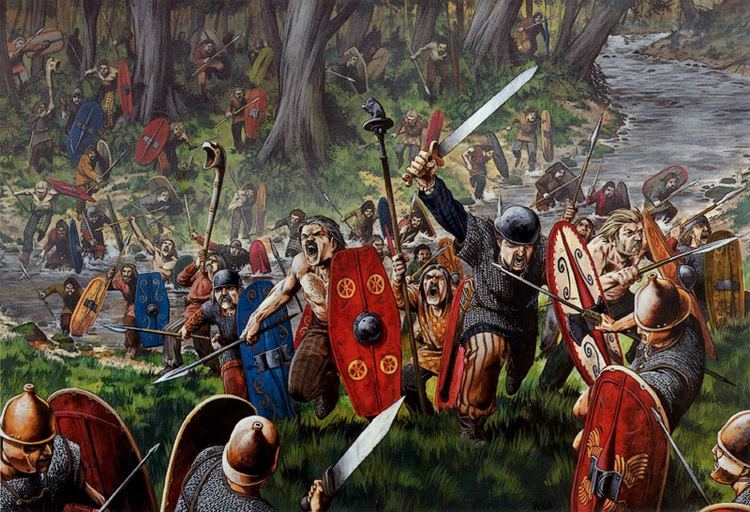
Battle of the Sabis (57 BCE): fight in which Julius Caesar defeated the Belgian tribe of the Nervians. The Sabis is identical to the modern river Selle in northern France. Read through this website to hear Julius Caesar's own accounts of the battle.
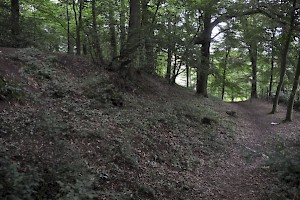
After Julius Caesar had defeated the Nervians at the Sabis (in French Flanders), he moved to the east, using an ancient road. His aim was to punish the Atuatuci, who had assisted the Nervians. He cornered them in a hillfort (oppidum) immediately south of modern Thuin. Caesar describes the events in section 29-31 of book 2 of his Commentaries on the war in Gaul. In an earlier chapter, Caesar writes that there were 19,000 Aduatucan warriors; they were attacked by seven Roman legions, or 30,000 men.
The translation is by W. A. McDevitte and W. S. Bohn.
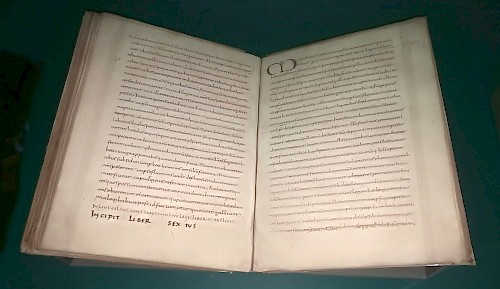
The Usipetes and Tencteri were two tribes who originally lived in what would now be called Central Germany. Culturally, they belonged to the La Tène-culture (the "Celts"): Usipetes means in the Celtic language "good horsemen". Expelled in 60 or 59 BCE from their homeland by the Suebi, a "real" German tribe arriving from the north, they wandered along the Rhine and in 56 arrived in the Dutch river area. Here, in the spring of 55, Caesar attacked them, hoping to pose as protector of Gaul against any invader from Germania. In December 2015, Dutch archaeologist Nico Roymans announced that he had identified the site of the massacre at Kessel-Lith in the Dutch river area.
The incident illustrates the ruthless nature of Roman aggression: Caesar first provoked the refugees and finally attacked them during an armistice. When the genocide became known in Rome, Senator Cato the Younger exclaimed that Caesar, the general of eight legions, was to be handed over to those Germans. Caesar was forced to divert the Senate's attention to other subjects, and spent the second half of the year with an invasion of Germania and an expedition to Britain. From a military point of view, both campaigns were unnecessary, but it gave Caesar great political advantages.
Caesar describes the event in his Commentaries on the war in Gaul, book 4, chapters 4-15. The translation is by Anne and Peter Wiseman.

In the spring of 55 BCE, Julius Caesar's soldiers attacked a large group of Germanic refugees during an armistice. Many people, belonging to the tribes of the Usipetes and Tencteri, were massacred. The Roman Senate discussed this shameful behavior, and Caesar dedided to divert the Senate's attention. During the early summer, he crossed the Rhine and invaded Germania; later, he even invaded Britain. These operations had little military purpose, but the Senate was impressed and that was what mattered.
The translation of Caesar's War in Gaul 4.16-19 was made by Anne and Peter Wiseman.
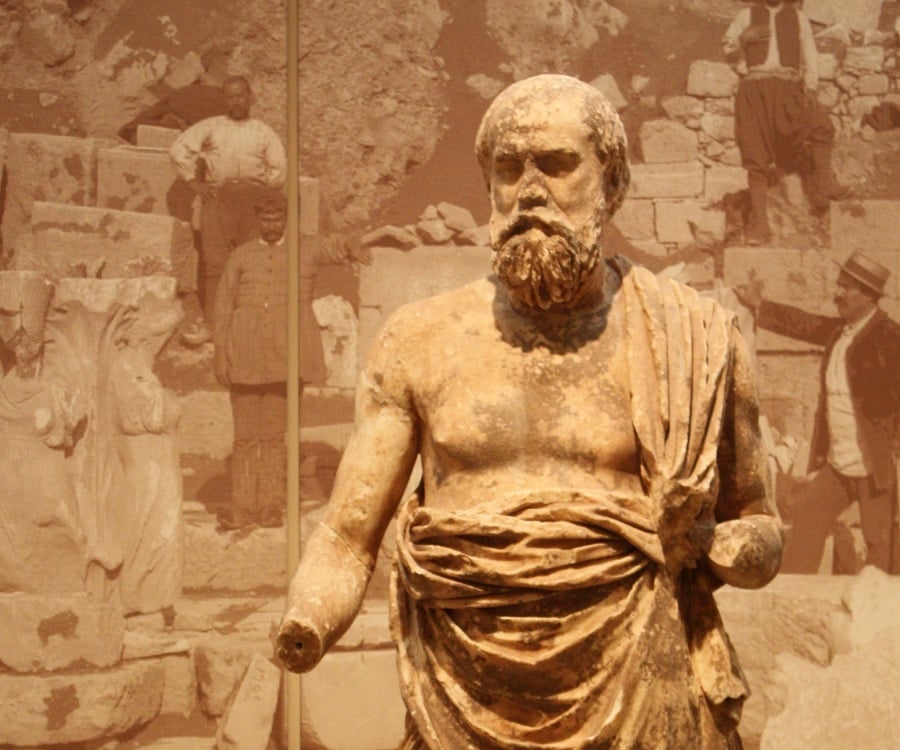
In April 56, Julius Caesar, Crassus, and Pompey discussed the future of their political collaboration in Lucca. The Greek author Plutarch of Chaeronea describes what happened in chapter 21 of his Life of Julius Caesar.
The translation was made by Robin Seager.
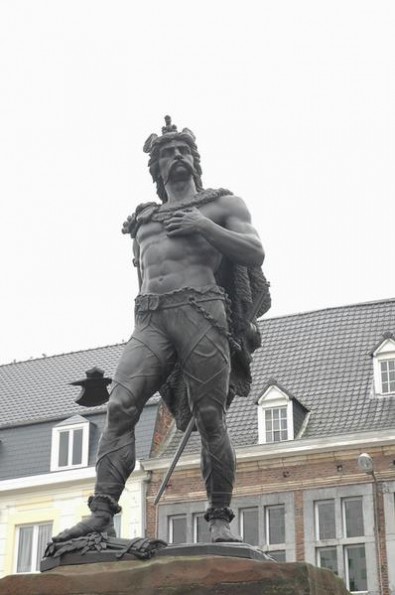
In the summer of 57 BCE, the Roman general Julius Caesar invaded the country of the rivers Scheldt and Meuse. Proceeding along an ancient road, first defeated the Nervians in the Battle of the Sabis in Flanders and continued to the east, where he forced the Aduatuci of eastern Belgium into submission. According to his own statistics, almost 60,000 Nervians were killed and 53,000 Atuatuci were sold as slaves. The first number is probably exaggerated, but human misery must have been great.
This show of force marked the beginning of the Roman occupation of the Meuse valley, which was to last for more than four and a half centuries. At first, the Romans were content to dissolve the old political ties. For example, strong tribes were forced to free their client tribes (i.e., dependent tribes). The only truly repressive measure must have been the seizing of hostages, a common instrument to keep subjects subjected.
Among those freed in the autumn of 57, were the Eburones, a tribe living between the rivers Meuse and Rhine. They may have been grateful at first, but this changed in the winter of 55/54, when the Romans for the first time built camped in northern France and Belgium, and the weight of the occupation became heavier. However, the Romans did not notice or ignored their discontent.
Instead, they spent the summer in Britain, where Caesar defeated Casivellaunus, the war leader of the united British tribes. In their absence, the Belgian tribes -even more discontent because of a bad harvest- prepared a rebellion. (Evidence for their cooperation is the so-called "treasure of Ambiorix", which consists of coins of several tribes.) When the legions returned and spread out to their winter quarters, the rebels were ready to strike. They had timed their attack excellently: in the winter, when Caesar had gone south to visit his province Gallia Cisalpina (northern Italy). Their first target was well-chosen too: the recently recruited Fourteenth Legion with five cohorts, stationed among the Eburones.
The leader of the revolt was Indutiomarus, the leader of the Treverians, a tribe that lived in the valley of the Moselle. It is not clear what gave him the right to order the Eburones to attack the Romans, but it is probable that the Eburones had become a Treverian client tribe. However this may be, it is clear that the Treverians used the Eburones as a lightning rod: only when the northern tribe was successful, they would unmask themselves. Otherwise, they would keep themselves out of harm's way.
The rebellion is described by the Greek historian Cassius Dio (164-c.235) in this link.

In the winter of 54/53, the tribes of Gaul, which had seemed to be quiet, suddenly revolted. The Belgians started the rebellion. Eburones, commanded by Ambiorix, destroyed the Fourteenth Legion and it took Julius Caesar a whole year before he had restored order. Next year, 52, the Gauls unitedly rebelled under Vercingetorix. It was well-timed, because the situation in Italy was unquiet too, and Caesar could not be reinforced. For the first time during this war, the Romans were was forced to defend themselves. However, Caesar was able to seize the initiative and took Avaricum (modern Bourges), an important Gallic stronghold.
Caesar has described the siege in his Commentaries on the war in Gaul, book 7, chapters 14-30. The translation is by Anne and Peter Wiseman.

The siege of Alesia (52 BCE), discussed on this page, was one of the most important battles during Caesar's conquest of Gaul. After he had captured this Gallic town, only mopping-up operations remained. Caesar described the siege in his Commentaries on the war in Gaul, book 7, chapters 63-90. The translation is by Anne and Peter Wiseman.

On this webpage, you can find a translation of Caesar's own account of the decisive battle; chapters 3.88-99 of the Civil War were translated by W. A. McDevitte and W. S. Bohn.
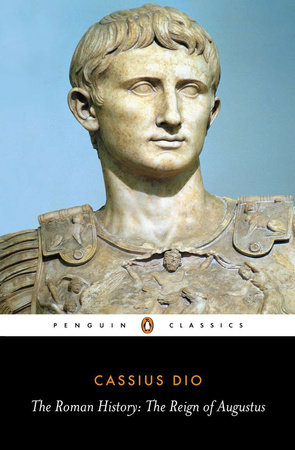
In the winter of 48/47, Julius Caesar crossed to Greece, where he wanted to fight against his rival Pompey. However, Pompey was able to block Caesar at Dyrrhachium (modern Dürres). In March, Caesar's colonel Mark Antony managed to reinforce him with four new legions, and on 7 July, the Caesarians were able to move away from the beach, an advance that resembled a flight. The story of the events after the breakout is told by several authors (including Caesar himself); here you can read the account in the Roman History (41.52-63) by Cassius Dio (164-c.235).
The translation was made by Earnest Cary.
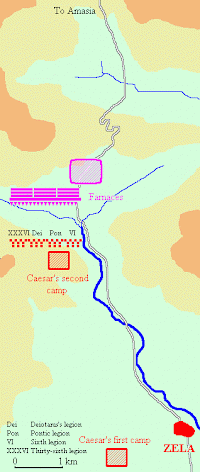
The battle of Zela took place on 2 August 47 (on the Roman calendar; 21 May 47 BCE on ours). An account was written by an anonymous officer, maybe Caesar's lieutenant Aulus Hirtius. Sections 65-77 of the Alexandrine War were translated by W. A. McDevitte and W. S. Bohn.

In April 46, Julius Caesar celebrated a quadruple triumph, which became famous for its extravagance. The end of four wars was celebrated: the war in Gaul, the war in Egypt, the war against Pharnaces of Pontus and the war against king Juba of Numidia. This last war had in fact been a war against the last defenders of the Roman republic, Cato and Scipio. The triumphs are described by the great Greek historian Appian of Alexandria (c.95-c.165) in his History of the Civil Wars.
The translation was made by John Carter.

On 15 March 44 BCE, the Roman dictator Julius Caesar was murdered. There are several accounts of this incident, but the most famous and probably most accurate is the one written by Caesar's biographer Gaius Suetonius Tranquillus (c.70-c.135), who seems to have had access to imperial archives and may have consulted eyewitness accounts.
The following fragment from his Lives of the Twelve Caesars ("Caesar" 80-82) was translated by Joseph Gavorse.

On 15 March 44 BCE, the Roman dictator Julius Caesar was murdered. A few days later, he was cremated on the Roman forum. There are several accounts of this incident, but the most famous and probably most accurate is the one that was written by Caesar's biographer Gaius Suetonius Tranquillus (c.70-c.135), who may have consulted eyewitness accounts.
The following fragment from his Lives of the Twelve Caesars ("Caesar" 84-85) was translated by Joseph Gavorse.

Julius Caesar was murdered on 15 March 44 BCE and the funeral ceremony took place a few days later. The body was exposed and Mark Antony, as consul Caesar's colleague, was to deliver a funeral oration. It is not known what he said, but the result was that the Roman masses became very angry with Caesar's murderers, burned down their houses, and made them flee from the city they had wanted to liberate.
The Greek historian Appian of Alexandria (c.95-c.165) has included several speeches in his History of the Civil Wars, all of them being own compositions (2.101). However, the speech of Antony is not a composition, but a report of what was said. It is a tempting idea that Appian's account is an accurate rendering of the words that were spoken during Caesar's burial.
The translation was made by John Carter.

The linked text was written by the Greek historian Appian of Alexandria (c.95-c.165) and is a part of his History of the Civil wars (2.149-154). It is the end of his description of Caesar's career, and Appian, a Greek, gives the Roman the ultimate compliment: he was comparable to Alexander.
The translation was made by John Carter.

